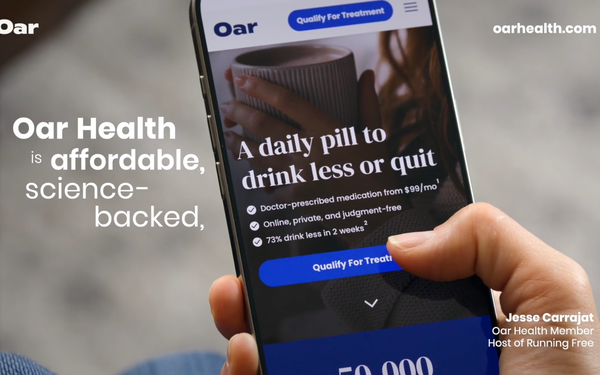
Yes, there Is an FDA-approved
medication designed to combat alcohol addiction.
Called naltrexone, it’s been available for decades, but has received little consumer promotion.
That’s largely because the
drug had already become generic by the time D2C pharma advertising began on TV in 1997 -- according to Jonathan Hunt-Glassman, founder/CEO of Oar Health. The company is launching its third consumer
awareness campaign this year for its naltrexone telehealth service, which offers doctor consultations, prescriptions and support.
Unlike the first campaign, which basically stated the problem and the solution, or the second campaign, in which former health insurance exec Hunt-Glassman described his own addiction resolution that led to the company’s
launch in 2021, the latest campaign features testimonials from three of Oar Health’s 12,000 current subscribers -- along with another appearance by Hunt-Glassman.
advertisement
advertisement
You can chalk that up
to Neil Walker, Oar Health’s vice president of growth, who, prior to joining the company two years ago, held a similar position at Ro, whose founder Zachariah Reitano starred in a number of ads
talking about his own erectile disfunction,
The next step in that campaign was also patient testimonials, which helped break down
stigma for prospective patients, Walker tells Marketing Daily.
The Oar Health campaign starts with a :60 spot running “almost entirely” on linear TV, which Walker calls a
valuable way to reach Oar’s target audience, which has both a median and mean age of 43. That’s not necessarily because younger people don’t have alcohol use disorder (AUD),
but as Hunt-Glassman adds, they’re less prone to seek treatment.
While men are slightly more likely to have AUD, Walker notes, “women are more likely to do something about
it.” But Oar’s advertising is mostly aimed at men, “because if you aim at men, you probably still get women. But if you aim at women, you might not get the men.”
So,
the media mix is heavy on news, business and sport programming, Walker says, using such networks at MSNBC, CNN, BBC World News, ESPN, Golf Channel and NFL Network. Mornings and daytime are most
prevalent, with some prime time.
“We measure TV on its ability to drive an initial response,” relates Walker, as well as on “how much brand search changes.”
Oar
largely relies on the inclusion of SMS as a call-to-action in its ads.
Walker says this is partly a response to spots running in prime time, in which viewers would visit the Oar website, but
not “take another step.”
“With SMS,” he says, “we grab that intent and then text them.” Furthermore, “we’ve learned through trial and error that
there are key moments in the week and in the day where people are much more willing to make a change in this area.”
So Oar does not text people with AUD at 9 p.m., but might do so at 9
a.m., when they’re in the midst of a hangover.
Monday mornings are big, Walker says, as are the mornings after “drinking holidays.” Cue up Nov. 1.
“That’s
one of the advantages of a telehealth-enabled solution. We’re able to meet people when they’re ready to start making a change,” says Hunt-Glassman. With addiction, he continues,
“it’s important to reach people in those moments of maximum motivation.”
Hunt-Glassman says Oar has cumulatively served 65,000 people since its launch, “two-thirds of
whom report they are always or frequently meeting their goal to drink less or quit.”
While naltrexone has been approved to treat opioid addition even longer than it has for alcohol
(since 1984), Hunt-Glassman says that Oar Health plans to keep focusing on alcohol. “We’ve been doubling revenue since launch,” he explains, “and we want to keep doing that and
help as many of the 28 million people with AUD as possible.” Currently, he says,” only about 2.5% of them are prescribed any medication to help them drink less or quit.”
In
addition to linear TV, Walker says, Oar also runs consumer advertising over paid search, radio, Facebook and LinkedIn.
Metrics on the latter and other research have shown Oar that
“people in ad agencies, branding and marketing…over-index for alcohol use disorder” due to job stress. Besides stress, the other major driver of AUD is relationships, he
relates.
Agencies involved with the new campaign include VideGro for the video creative and Tatari for TV buying.